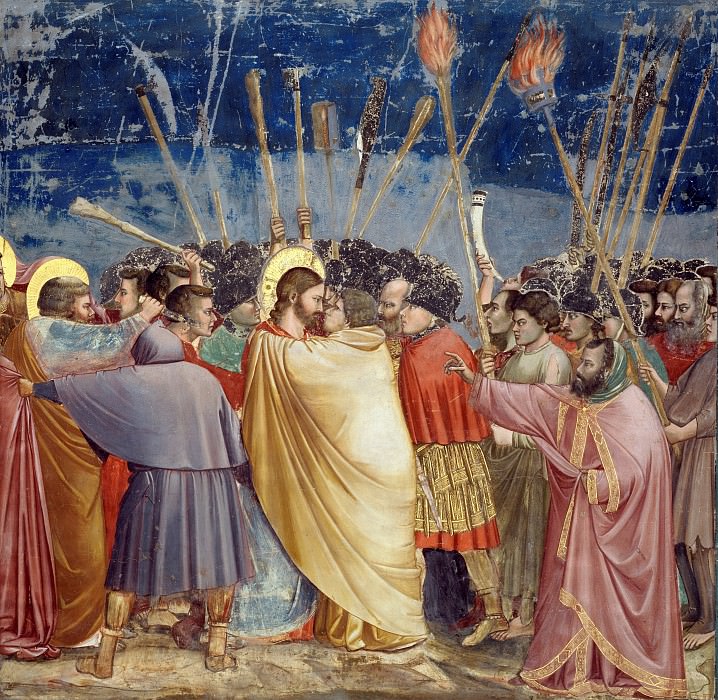31. The Arrest of Christ (Kiss of Judas) Giotto di Bondone (1266-1337)
Giotto di Bondone – 31. The Arrest of Christ (Kiss of Judas)
Edit attribution
Download full size: 3371×3287 px (5,1 Mb)
Painter: Giotto di Bondone
Florentine painter Giotto di Bondone was one of the first artists to depict Judas the Traitor. His painting of the Paduan cycle, The Kiss of Judas, is a prime example of this. This famous painting tells the beholder about the confrontation of good and evil, about the greatness of the soul and meanness. The entire background of the canvas is a dark blue sky, to which spears and lit torches are raised.
Description of Giotto di Bondone’s painting The Kiss of Judas
Florentine painter Giotto di Bondone was one of the first artists to depict Judas the Traitor. His painting of the Paduan cycle, The Kiss of Judas, is a prime example of this. This famous painting tells the beholder about the confrontation of good and evil, about the greatness of the soul and meanness.
The entire background of the canvas is a dark blue sky, to which spears and lit torches are raised. Amidst this bustle, two figures standing in profile stand out - Jesus Christ and his disciple Judas of Iscariot. The savior and the traitor look into the eyes of the opponent. Here Giotto very skillfully conveys the inner world of the biblical characters with the help of paints. Thus, Christ has a flawless appearance of antique beauty, but Judas looks ugly, his face with a low forehead is quite unpleasant.
We can say that Giotto’s subject of the painting The Kiss of Judas was cut from the Gospel story of how the disciple betrayed his Master. Giotto depicted in the fresco how Judas brought guards to capture his teacher, but before doing so he hypocritically embraces him. Torches are blazing all around, spears and clubs are flashing, creating a stirring picture. The crowd is in turmoil, everyone is in an increasing state of tension. Two opposites - the high and the immoral - come together.
With the help of graphic elements and techniques of painting, the master of the brush was able to subtly convey all the feelings that the characters experience in their silent dialogue. The feelings of the interlocutors are conveyed only by their glances and gestures.
By all means the artist tries to bring the scene to life: he presents the figures in profile, taking them into the depths of the painting. Giotto seems to be inviting the audience to take their place in the picture, so that it is easier to define their attitude to the events.
Connoisseurs of Giotto’s work consider his The Kiss of Judas one of the most impressive frescoes with a dramatic subject.
Кому понравилось
Пожалуйста, подождите
На эту операцию может потребоваться несколько секунд.
Информация появится в новом окне,
если открытие новых окон не запрещено в настройках вашего браузера.
You need to login
Для работы с коллекциями – пожалуйста, войдите в аккаунт (open in new window).




















You cannot comment Why?
The composition is dynamic and chaotic, conveying the confrontation and violence of the moment. The figures are rendered with emotional intensity, particularly the grim expressions of the soldiers and the serene yet resigned gaze of Jesus.
The subtext of the image is the biblical narrative of betrayal and the beginning of Christs Passion. Judass kiss, a sign of treachery, leads to Jesuss arrest and subsequent crucifixion. The artwork emphasizes themes of loyalty and betrayal, sacrifice, and the clash between divine love and human treachery. The dark, agitated background and the upward thrust of weapons create a sense of foreboding and spiritual turmoil.